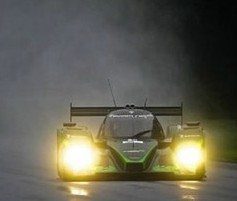Racing has been part of the automobile since its inception and remains integral to the industry today. “What wins on Sunday sells on Monday” is a long-held motor-sport adage for a reason: Racing spawns new technology and boosts sales.
Lord Paul Drayson, Britain’s former minister of science and innovation, believes racing can have the same impact on electric vehicles. He became concerned about climate change while serving under Prime Minister Gordon Brown from 2007 until 2010. Today he’s developing an all-electric race car and race series. It’s a marriage of interests for Lord Drayson, who is an accomplished race car builder and driver who competes in the American Le Mans Series.
The Drayson Racing electric prototype, designed with race-car builder Lola, has an 850 horsepower motor and accelerates from zero to 60 miles per hour in less than three seconds. Both Drayson and the Fédération Internationale de l’Automobile – the international sanctioning organization – hope to see an all-electric race car series debut as early as 2013.
Drayson and his wife, Elspeth, and five children live in London and Gloucestershire.
How can a new racing series boost sales of Workaday electric sedans?
People will judge the massive future potential of electric vehicles by watching cutting-edge technology out on the track. At present, we only have road cars to judge what an electric vehicle can do.
What sort of influence on the future market do you envision?
Racing drives innovation and leads to new ideas getting developed faster. This will improve the overall performance of electric vehicles.
What will draw fans to an electric car series?
It will make for spectacular racing – providing the cars are exciting and have plenty of power and are difficult to drive.
And this is all driven by your concern about climate change?
Absolutely. I visited Antarctica with my family over Christmas. It’s pretty shocking. As science minister, I obviously saw all the data, but seeing it for yourself up close is an emotional and scary experience. We are in a race to stop this kind of effect on our planet; electric racing can help by driving innovation and making green cars cool and exciting – not dull and boring.
You have driven a conventional race car in the famed 24 Hours of Le Mans. How is an electric race car different?
There is the enormous torque and flat-line delivery of power. It’s very different from a petrol engine and hard to control. You also notice the lack of any sound from the drivetrain as you leave the pits. Once on track you can’t hear anything.
Name a few major technical hurdles you will have to overcome to develop a competitive electric race car.
Integrating the electric drivetrain into the chassis to optimize weight, drag and balance and managing the cooling of the electric motors so they operate at maximum efficiency. We also need to build a battery and battery management system that provides sufficient energy and power.
Miss government work?
Yes I do. It was the most difficult and most interesting job that I have ever done. You can change things – and make a difference. It doesn’t get better than that.
What do you do to relax away from the race car business?
Spend time with my five kids, who are growing up fast.
This article was originally published on The Daily Climate – dailyclimate.org. Reproduced with permission.










